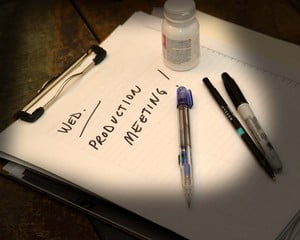You’ve been to them. ..those once-a-week production meetings where a dozen participants sit around a big table, and one at a time, they report in great detail all of the major accomplishments for the week, what they intend to complete by next week, and what big problems they continue to face. The level of detail that is used in this type of reporting is almost always more than those sitting around the table care to hear. A good strong pot of coffee is often provided, if for no other reason, than to keep everyone awake.
In many businesses, this type of meeting can probably not be avoided. Communications up and down the ranks, and between departments is absolutely essential in the manufacturing world. But, if your group is waiting for that weekly marathon meeting to make sure everything is getting done in the right manner, you may be missing out on a great little tool that can shorten that meeting, and at the same time, help to make every work day as efficiently productive as possible. The stand-up huddle meeting may help your team avoid many workplace problems before they get too big, allowing you to make modifications or adjustments to costs and schedule while those issues are still manageable.
So…what is a Stand-up Huddle? In our work world, the stand-up huddle is an early morning meeting that lasts for no more than 8 minutes. The rules are quite simple, but strictly enforced.
a) No one sits down. The whole idea is to keep the meeting brief. Sitting down can often take a meeting down a more leisurely path, and before you know it, your meeting will stretch over half an hour in length.
b) No coffee allowed. For the same reason as having a “standing up” rule, sipping coffee is not only discouraged, it’s not permitted at all.
c) No chit-chat. This is not a place to discuss the score of last night’s basketball game, the weather, or the price of eggs (unless, of course, these are topics of your business). Only work-related topics are covered, and particularly, those items that are critical for the work day you are about to start. In addition, try to train your team members that tend to be storytellers to abbreviate their report to key elements only.
d) Start on time. The goal is to have a daily meeting that does not take too much time away from actual production efforts. If the idea is to have an 8-minute meeting, then waiting for someone to show up can really defeat the purpose.
Here are some other tips for using the stand-up huddle in an effective manner.
1) Invite everyone you think might need to participate. But remember, the more involved, the greater the chance that someone might be late, or the conversations and questions will run long, etc. Think about what key people should be at the meeting. If a lot of people are necessary, consider the efficiency of breaking everything up into two or three simultaneous stand-up huddle meetings.
2. Have someone keep notes each day. These should not be long dissertations, but just a few phrases about the daily objectives and problem spots. Refer to these brief memos each morning to see if the goal was completed, or if it needs to carry over into the next work shift.
3. Hold the meeting in a location where there is not a lot of noise, traffic, or other types of distraction.
4. Finish the meeting by making sure that everyone has understood the discussions clearly and correctly. If there are questions, make sure that they are answered to the fullest possible extent, even if this is done off-line as a one-on-one with the appropriate people.
Not only will short daily meetings like the stand-up huddle help to make the work shift more productive, but the regular communication may actually help to abbreviate those once-a-week marathon meetings that are so commonly dreaded.




